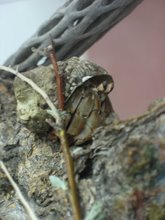Oxalic acid blocks calcium absorption. That is a big concern to hermit crab keepers who realize the importance of calcium in their pet’s diet. Calcium is necessary for formation and maintenance of exoskeleton. Therefore the question arises: What are safe levels of oxalic acid and how often should foods high in oxalic acid be offered?
Extensive research has been done on oxalic acid’s affects on humans since kidney stones are thought to be formed by crystals formed when oxalic acid combines w/ calcium, iron, and other minerals. These crystals (oxalates) form in the digestive system and once they enter the bloodstream the calcium particles are too large to be absorbed and are eliminated as waste through the kidney and bladder. How this process translates into hermit crab physiology is uncertain, but calcium that is rendered unusable is reason for concern.
Some cautiously avoid all high oxalic foods altogether, but this may not be the best course of action because many of the foods in this class are otherwise highly nutritious. Many of the ingredients recommended for beginning crab keepers are somewhat high in oxalic acid. So, what is one to do? Some sources say that the oxalic acid affect can be reduced or eliminated by heating, but that could harm many of the other valuable nutrients in the plant. Success rests on understanding the complete nutrient content of the high oxalic acid foods you are considering and weighing the risk vs. benefits. Spinach, for instance, is very high in both oxalic acid and calcium. Mathematically, the oxalic acid content probably renders nearly all of the calcium unavailable. However, if you figure in the fact that B6 and magnesium also present in spinach retards the chemical binding of the calcium*, the typical result is that hermit crabs will still get some calcium from spinach as well as a whole host of nutrients like beta carotene, zeaxanthin, A, and potassium. So, from that point of view, your crab should eat spinach--unless he happens to be prone to kidney stones!
It is important to determine how much oxalic acid is in the foods that you feed so that you can offset it with other sources of calcium, iron, and other minerals. If you know you are feeding a high oxalic food, consider dusting it with powdered cuttlebone and offering a low oxalic food the following day. High oxalic foods are best avoided during pre-molt and post-molt. Unripe fruits and vegetables tend to have higher oxalic content, so a ripe (red) bell pepper is better than a green bell pepper. Also, young shoots tend to have more oxalic acid than mature leaves as in the case of spinach.
High Oxalic Acid Content:
Buckwheat, starfruit, parsley, poppy seed, rhubarb, amaranth, beet leaves, spinach, Swiss chard, beets, banana, plantain, ginger, cassava, nuts, berries, beans, bell peppers, sweet potatoes, soybeans, tomatillos, oats, pumpkin, cabbage mango, eggplant, lentils, parsnips.
Low Oxalic Acid Content:
Dandelion greens, most ripe fruits, kale, watercress, escarole, mustard greens, turnip greens, broccoli, tomatoes, asparagus, cabbage.
*Here is the formula I’ve developed:
oxalic acid (mg) X .097 = x, x - total calcium (mg) = actual absorbable calcium
Subscribe to:
Post Comments (Atom)



5 comments:
Talking with Sue {chestersmom} she did explain to me that oxalic acid was an important part of hermit crab diet and physiology and that they MUST have external sources of it, obviously it is something to limit and offer plenty of alternate sources, as you explained, but it is still an important part of their diet.
Thanks for sharing that! I'd tried to run by these theories with Sue quite some time ago, but she was unable to respond. Nearly every kind of plant we can offer has some oxalic acid or oxalates to one degree or another, so I don't think we will have to consciously include it into our feeding program; it will naturally be a part of a healthy diet that includes leaves, fruits, and vegetables.
Small molecular weight calcium salts, if absorbed intact, could provide a nutritional source of calcium in subjects with impaired absorption of calcium by the saturable pathway. An understanding of the mechanism of absorption of calcium oxalate (as a representative salt) may be important nutritionally and therapeutically.Calcium kinetics were fitted by a model with three compartments in the body and one absorption pathway from the intestine. By contrast, oxalic acid kinetics were fitted by two pools in the body and two absorption pathways from the intestine. Calcium and oxalic acid, therefore, demonstrate different absorption and distribution kinetics in rats.
---------------------
johnedwin
advicer
It is well known fact that in susceptible persons Oxalates in plant materials that they ingest combine with Calcium present in excess in Milk products and others, to form stones in the kidneys. For this stone formation many other co-existing factors contribute such as immobility of body etc. I too wonder how this could be extended to the Hermit Crab to boost its shell formation!
It was certainly interesting for me to read the article. Thanks for it. I like such themes and anything that is connected to this matter. I definitely want to read a bit more on that blog soon.
Post a Comment